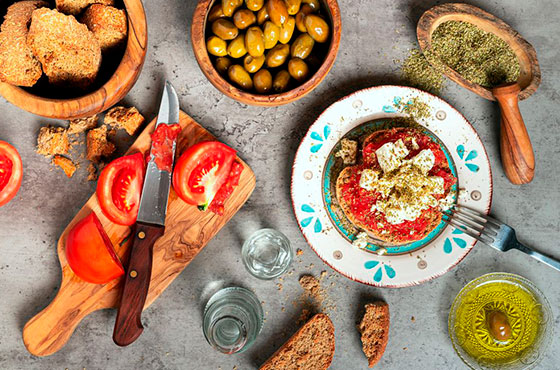Cretan Cuisine: Gastronomic Tours

Crete, with its rich gastronomic heritage, stands as one of the top destinations for food enthusiasts. Its cuisine reflects the island's rich history, cultural influences, and geographical diversity. From traditional dishes made with local ingredients to unique flavors offered in tavernas and restaurants, Crete's gastronomy showcases the authenticity and abundant heritage of the island.
The Basics of the Cretan Diet:
Cretan cuisine stands out for its high-quality and fresh local ingredients, as well as for the healthy choices it promotes. One of its main characteristics is the emphasis on olive oil, which is a key ingredient in many recipes and gives a unique aroma and flavor to dishes. Olive oil is known for its nutritional properties and antioxidant action, making it one of the main elements of Crete's healthy diet.
In addition to olive oil, abundant vegetables are a vital part of Cretan cuisine. Cretans enjoy a variety of fresh vegetables, often sourced from their local gardens and farms. With their high content of vitamins, minerals, and phytochemicals, vegetables contribute to maintaining a healthy lifestyle and offer a plethora of nutritional benefits.
Overall, Cretan cuisine seeks a balance between healthy ingredients and well-being, with an emphasis on natural, unprocessed, and nutrient-rich foods. The simplicity, variety, and quality of the ingredients make Cretan cuisine one of the healthiest and most flavorful cuisines worldwide.
Classic Cretan Dishes You Must Try:
-
Dakos: A traditional Cretan dish consisting of hard bread with olive oil, tomato, feta cheese, and finely chopped salt. It is a refreshing and flavorful snack that is typically served as a starter or dessert.
-
Kalitsounia: These are the classic Cretan kalitsounia, traditionally filled with minced meat, rice, herbs, and mushrooms, wrapped in an oat or meat pastry, and baked until golden brown.
-
Antikristo: Antikristo is a dish made from pieces of roasted meat, usually lamb or chicken, roasted with a variety of spices and vegetables. It is typically served with fresh bread and tsikoudia, a local spirit made from grapes.
These dishes are just a taste of the rich Cretan cuisine and are popular choices for both locals and visitors to the island.
Cretan Drinks and Sweets:
Raki and Cretan Wine:
One of the most popular traditional drinks in Crete is raki, a strong alcoholic beverage made from the distillation of grapes. Often served in small glasses, it accompanies Cretan celebrations and social gatherings. Cretan wine is also popular, with varieties like Cretan Liatiko and Cretan Malvasia gaining fame for their rich flavor and aroma.
Sweets:
Sweets are an important part of Cretan gastronomy and are usually served alongside meals or as desserts. A beloved sweet is "kaltsouni," a type of sweet bread containing aromatic spices and hazelnuts, flavored with orange and resin. Another legendary dessert is "loukoumades," small pieces of fluffy fried dough dipped in sweet syrup and typically sprinkled with grated nuts.
These traditional drinks and sweets are an integral aspect of Cretan culture, offering a flavorful experience that reflects the island's rich and diverse cuisine.
Tours of local markets and restaurants:
In Crete, there are many local markets where visitors can enjoy fresh local products and explore the local culture. Some of the most popular markets include the Chania Market, the Rethymnon Market, and the Heraklion Market. In these markets, visitors can find fresh fruits, vegetables, cheeses, olive oil, and local delicacies.
Recommended restaurants offer a pleasant dining experience with authentic Cretan cuisine. It is important to highlight the variety of dishes offered, the quality of the ingredients used, and the atmosphere of the restaurant.
Visitors can expect to try traditional Cretan dishes such as ntako, kalitsounia, and antikristo. Recommended restaurants often emphasize the quality of the products and the traditional preparation of the dishes, offering an authentic culinary experience. Additionally, the atmosphere of the restaurants often reflects traditional Cretan hospitality, providing a warm and friendly environment for guests.
- Taverns in traditional villages: Taverns located in traditional villages usually offer dishes with local ingredients and traditional recipes.
- Beachfront restaurants: Restaurants located near the beaches often offer fresh seafood and Mediterranean flavors, usually combined with local products.
- Restaurants in cities and towns: Major cities and towns often host restaurants that offer a variety of Cretan and Mediterranean flavors, often with a modern twist.
